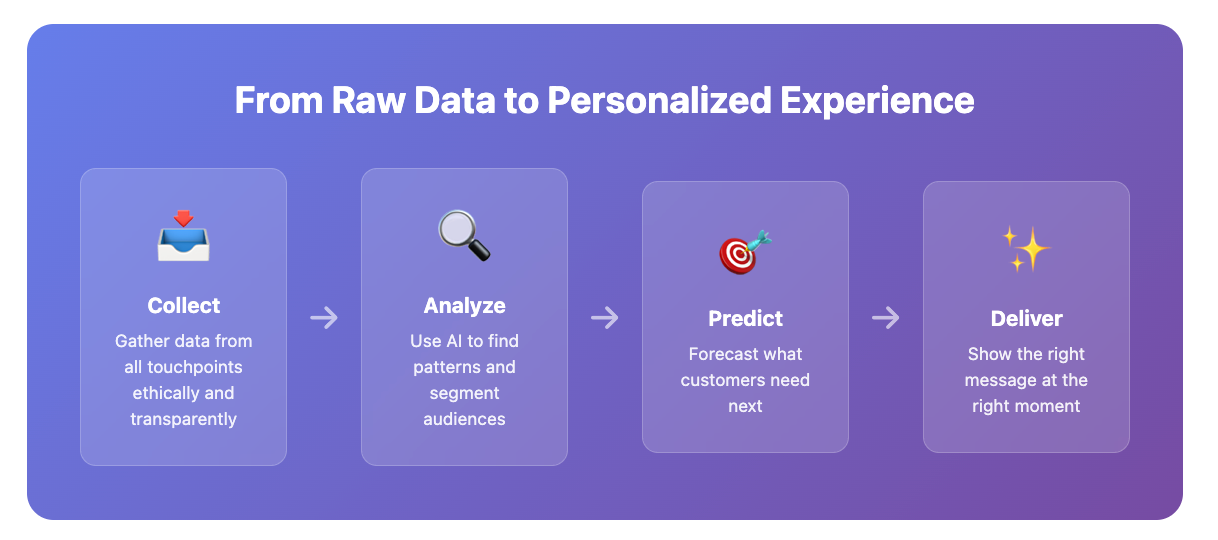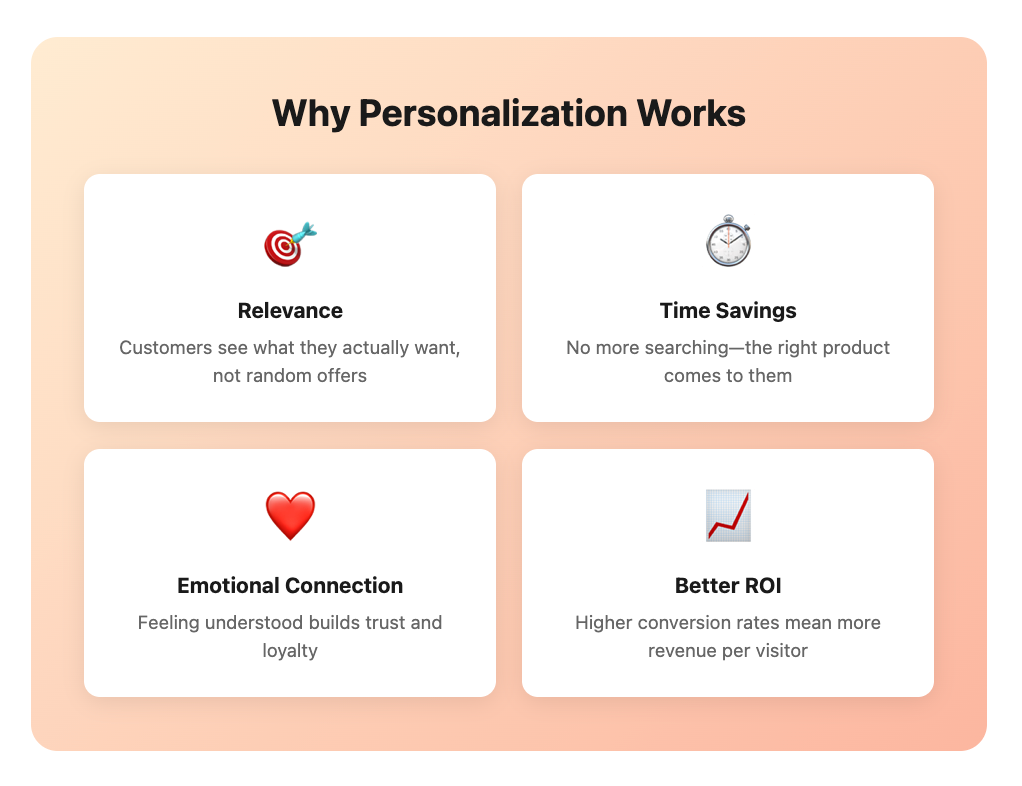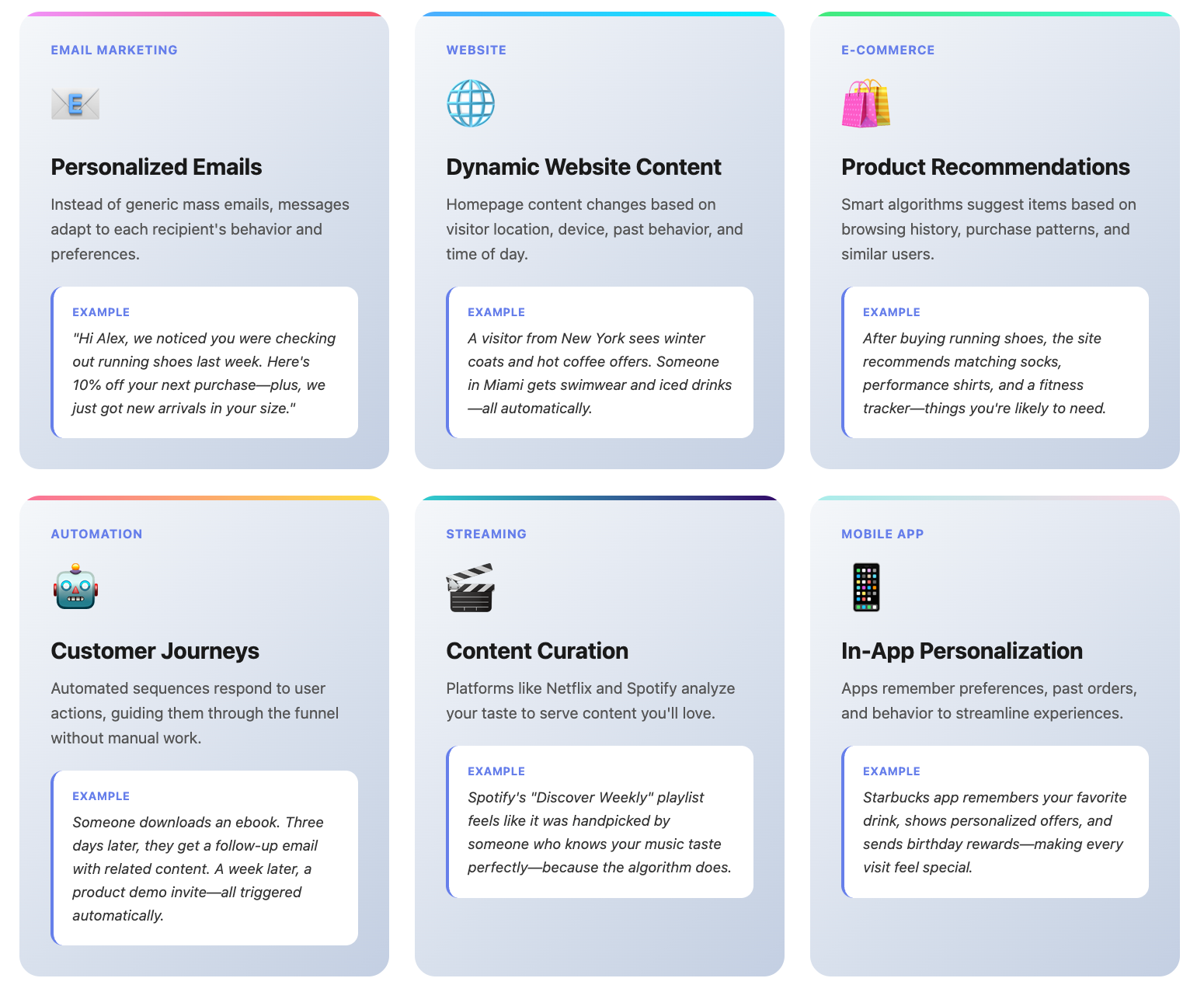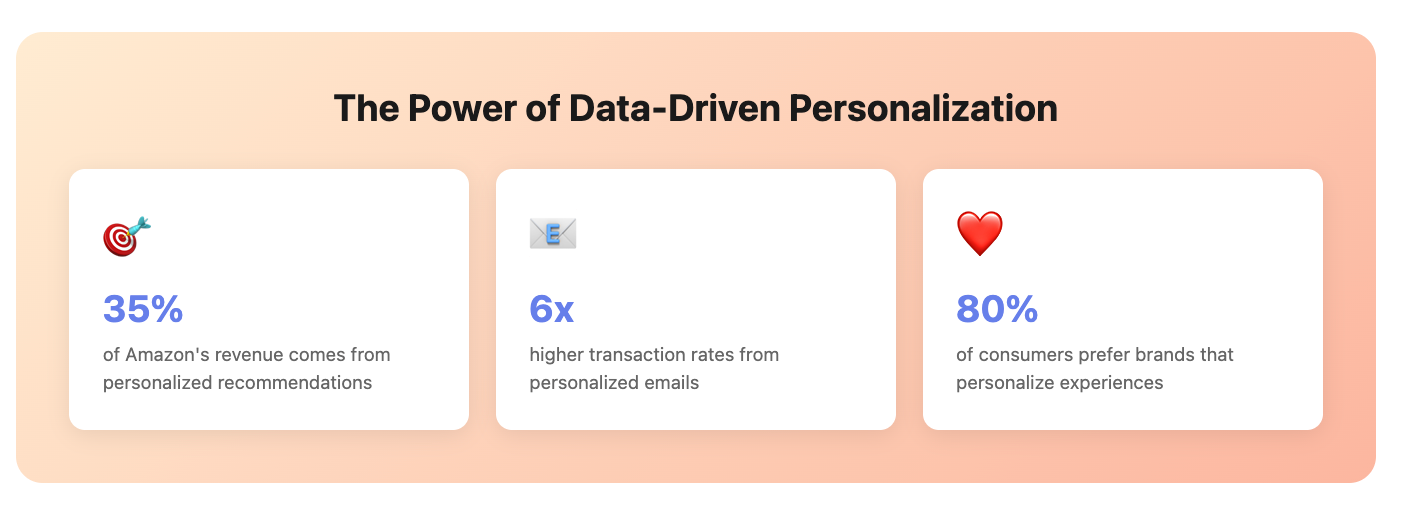Personalization


Marketing manager Sarah just sent an email campaign to fifty thousand subscribers.
One message. One offer. One tone — for everyone.
The open rate? Three percent.
Conversions? Barely half a percent.
The budget was gone, and the campaign flopped.
A month later, Sarah tried something new.
She split her audience into groups — those who had bought sneakers, those who had looked at backpacks, and those who only browsed the catalog. Each segment got a personalized email with a relevant offer.
This time, the open rate shot up to twenty percent.
Sales increased sevenfold.
That’s the magic of personalization — it not only changes marketing performance but also transforms how people feel about a brand. Customers stopped deleting emails without reading them. They started waiting for them — because every message felt like it was written just for them.
What Is Personalization?
Personalization means tailoring a product, service, or communication to the needs of an individual user.
A brand collects customer data and uses it to create a unique experience.
Example: you visit an online store. The system greets you by name. It remembers that you were looking for men’s running shoes, size 9, and shows a banner with the same model — now with a 5% discount.
That’s personalization in action.
It all runs on data. Brands track user behavior — what people view, buy, how long they stay on the site, which emails they open. Algorithms analyze that data and automatically generate content that matches each person’s interests.
Personalization brings brands closer to their customers. It turns mass communication into a dialogue.
People feel seen and understood — and that emotional connection drives loyalty.

Personalization vs. Customization: What’s the Difference?
Many people mix up these two concepts, but the difference is huge.
- Personalization happens when the brand itself adapts the experience to the user.
You don’t ask Netflix to show you family dramas — it analyzes your watch history and recommends them automatically.
- Customization happens when the user actively changes the product or service.
For example, on Nike By You, you design your own sneakers — choose the colors, materials, maybe even add your initials.
The key difference:
Personalization is automatic and invisible.
Customization is manual and deliberate.
Both make customers feel valued, but they serve different purposes — one builds seamless experiences, the other empowers creativity.
Why Personalization Matters for Business
Personalization isn’t just a marketing buzzword — it’s a growth engine.
When done right, it boosts engagement, sales, and customer lifetime value. But even more importantly, it builds trust.
Think about how people interact with brands today. Every day, we see thousands of ads, emails, and push notifications. Most of them feel irrelevant — background noise we scroll past without thinking. But when a message hits exactly what we need, it grabs attention.
That’s personalization at work.
It cuts through the noise and says:
“We know what you care about — and here’s something that truly fits you.”
1. Better conversion rates
Personalized marketing increases conversion because it reduces friction.
If a user sees products they already like, they make decisions faster.
Amazon reports that 35% of its total revenue comes from personalized recommendations.
Spotify’s “Discover Weekly” keeps people listening longer because it feels like every playlist was made for them.
2. Higher customer retention
When a brand remembers who you are, you’re more likely to come back.
Starbucks, for instance, uses purchase data from its mobile app to recommend new drinks or send birthday offers. That simple touch creates a feeling of being recognized and appreciated.
According to Epsilon, 80% of consumers are more likely to buy from brands that offer personalized experiences.
3. More efficient marketing spend
Personalization makes marketing smarter.
Instead of sending ten emails to everyone, you send one relevant message to the right segment — and get better ROI.
That’s exactly what Sarah from our opening story discovered. She didn’t increase her budget — she just made every message count.

The Data Behind Personalization
Personalization lives and dies by data. The more accurately a company understands its users, the better it can tailor communication.
Sources of data:
- Behavioral data: website visits, clicks, time spent on pages, abandoned carts.
- Transactional data: purchases, subscription renewals, order frequency.
- Demographic data: age, gender, location, device type.
- Contextual data: time of day, seasonality, or even the weather.
All this information helps brands predict what a person might want next.
For example, an online bookstore might notice you often buy sci-fi novels — and recommend new releases in that genre before you even start searching.
Modern personalization doesn’t rely on guesswork. It uses AI algorithms and predictive models that learn from every user interaction.
Levels of Personalization
Not all personalization is the same. Some brands stop at basic segmentation, while others use deep, real-time data to craft unique experiences.
Let’s break it down into levels:
1. Basic: Rule-based personalization
This is the simplest form — think of “Welcome, John!” in an email or product recommendations like “Customers who bought this also bought…”
It’s effective but limited. It doesn’t adapt to behavior in real time.
2. Dynamic: Data-driven personalization
Here, algorithms analyze user behavior and adjust content automatically.
For instance, a news app might show you more tech stories if you frequently read about AI.
3. Predictive: AI-powered personalization
This is where things get advanced.
AI predicts user intent — before it’s even expressed — and tailors experiences across every channel: website, app, ads, and email.
Netflix, for example, personalizes not only movie recommendations but also the thumbnails you see. The same movie might have different cover images for different users based on what they tend to click.
The Power of Personalization: Why Customers Expect You to Know Them
In the mid-2000s, Sarah, a marketing manager at a small fashion brand in Chicago, had a simple but effective routine. Every Friday, she emailed her subscribers about new arrivals — the same message for everyone. It worked for a while, but over time, engagement dropped. People stopped opening her emails.
Fast forward to today. Sending one message to everyone is no longer enough. Customers expect more. They want to feel that a brand knows who they are, what they like, and when to reach out.
That’s where personalization comes in — not as a buzzword, but as a strategic advantage.
What Is Personalization in Marketing?
Personalization means tailoring communication, offers, and experiences to each customer based on their data — demographics, behavior, purchase history, and interests.
It’s what makes Netflix recommend shows you’ll actually enjoy, and what prompts your favorite online store to show you shoes that match your recent purchase.
In marketing, personalization can happen across all touchpoints: email, website, chat, ads, and even customer support.
Why Personalization Works
- It builds emotional connection. People trust brands that “get” them.
- It increases conversion. Personalized content drives higher engagement and sales.
- It reduces noise. When communication feels relevant, customers pay attention.
In short: personalization turns data into relationships.
Examples of Personalization in Action
Personalized Emails
Instead of “Hey there,” the email starts with “Hi, Alex.” It references what Alex recently viewed on the site and offers a 10% discount on those exact items.
Dynamic Website Content
A visitor from New York sees different offers than one from Los Angeles — based on region, season, or previous behavior.
Product Recommendations
A returning customer who bought running shoes might see accessories or new arrivals in the same style.
Automated Customer Journeys
A lead downloads an ebook — the system recognizes it, triggers a series of follow-up emails, and moves them down the funnel without a single manual step.

How to Start Personalizing Your Marketing
- Collect data ethically. Use opt-in forms, chatbots, and CRM integrations.
- Segment your audience. Group users by interests, behavior, or purchase stage.
- Use automation. Platforms like HubSpot, or ActiveCampaign help automate personalization at scale.
- Test and adjust. Personalization is not “set it and forget it.” Analyze engagement and improve over time.
Personalization and Privacy: Finding the Balance
Americans are increasingly concerned about how brands use their data. Transparency builds trust. Always explain what information is collected and why — and give users control over their preferences.
The Future of Personalization
AI is making hyper-personalization accessible to everyone. Neural networks can now analyze behavior in real time and create tailored messages automatically — turning what used to take days into seconds.
Soon, customers won’t just expect personalization — they’ll demand it. And brands that fail to adapt risk being ignored altogether.
Final Thought
Sarah, our marketing manager, no longer sends one-size-fits-all emails. Her messages now adapt to each subscriber — timing, tone, and product suggestions. The result? Higher open rates, more conversions, and happier customers.
Personalization isn’t about technology. It’s about respect — understanding people, not audiences.


